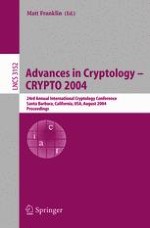Crypto 2004, the 24th Annual Crypto Conference, was sponsored by the Int- national Association for Cryptologic Research (IACR) in cooperation with the IEEE Computer Society Technical Committee on Security and Privacy and the Computer Science Department of the University of California at Santa Barbara. The program committee accepted 33 papers for presentation at the conf- ence. These were selected from a total of 211 submissions. Each paper received at least three independent reviews. The selection process included a Web-based discussion phase, and a one-day program committee meeting at New York U- versity. These proceedings include updated versions of the 33 accepted papers. The authors had a few weeks to revise them, aided by comments from the reviewers. However, the revisions were not subjected to any editorial review. Theconferenceprogramincludedtwoinvitedlectures.VictorShoup’sinvited talk was a survey on chosen ciphertext security in public-key encryption. Susan Landau’s invited talk was entitled “Security, Liberty, and Electronic Commu- cations”. Her extended abstract is included in these proceedings. We continued the tradition of a Rump Session, chaired by Stuart Haber. Those presentations (always short, often serious) are not included here.
